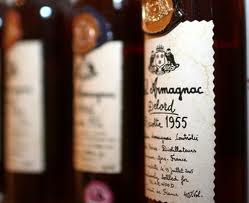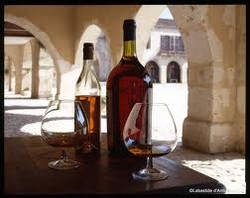
Armagnac is the oldest type of Brandy in France, with documented references to distillation dating back to the early 15th century. The Armagnac region is located in the heart of the ancient province of Gascony in the southwest corner of France. As in Cognac, there are regional growing zones: Bas-Armagnac, Haut Armagnac, and Tenareze. The primary grapes used in making Armagnac are likewise the Ugni Blanc, Folle Blanche, and Colombard. But distillation takes place in the unique alambic Armagnacais, a type of column still that is even more “inefficient” than a typical Cognac pot still.
The resulting brandy has a rustic, assertive character and aroma that requires additional cask aging to mellow it out. The best Armagnacs are aged in casks made from the local Monlezun oak. In recent years Limousin and Troncais oak casks have been added to the mix of casks as suitable Monlezun oak becomes harder to find.
Most Armagnacs are blends, but unlike Cognac, single vintages and single vineyard bottlings can be found. The categories of Armagnac are generally the same as those of Cognac (V.S., V.S.O.P., X.O., etc.). Blended Armagnacs frequently have a greater percentage of older vintages in their mix than comparable Cognacs, making them a better value for the discerning buyer.
The resulting brandy has a rustic, assertive character and aroma that requires additional cask aging to mellow it out. The best Armagnacs are aged in casks made from the local Monlezun oak. In recent years Limousin and Troncais oak casks have been added to the mix of casks as suitable Monlezun oak becomes harder to find.
Most Armagnacs are blends, but unlike Cognac, single vintages and single vineyard bottlings can be found. The categories of Armagnac are generally the same as those of Cognac (V.S., V.S.O.P., X.O., etc.). Blended Armagnacs frequently have a greater percentage of older vintages in their mix than comparable Cognacs, making them a better value for the discerning buyer.

Have Still, Will Travel
Up until the 1970s, portable alambic Armagnacais mounted on two-wheel carts were hauled among small vineyards in Armangnac by itinerant distillers called bouillers de cru. These traveling stills, alas, have mostly given way to larger fixed-in-place setups operated by farmer cooperatives and individual operators.
French Brandy is the catch-all designation for Brandy produced from grapes grown in other regions. These Brandies are usually distilled in column stills and aged in oak casks for varying periods of time. They are frequently blended with wine, grape juice, oak flavorings, and other Brandies, including Cognac, in order to smooth out the rough edges. Cognac-like quality designations such as V.S.O.P. and Napoleon are frequently used, but have no legal standing.
Up until the 1970s, portable alambic Armagnacais mounted on two-wheel carts were hauled among small vineyards in Armangnac by itinerant distillers called bouillers de cru. These traveling stills, alas, have mostly given way to larger fixed-in-place setups operated by farmer cooperatives and individual operators.
French Brandy is the catch-all designation for Brandy produced from grapes grown in other regions. These Brandies are usually distilled in column stills and aged in oak casks for varying periods of time. They are frequently blended with wine, grape juice, oak flavorings, and other Brandies, including Cognac, in order to smooth out the rough edges. Cognac-like quality designations such as V.S.O.P. and Napoleon are frequently used, but have no legal standing.
